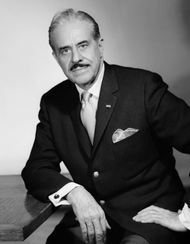Designer Spotlight: Raymond Loewy
Posted by Harvey Schwartz on Jan 24th 2020
The role of an industrial designer is a difficult one. Through his knowledge of applied art, he must create a manufactured article that will appeal aesthetically to the consumer and result in its purchase. Sales interest, stylistic trends and various other considerations are usually employed to determine how a product should look.
One of the founding fathers of industrial design and certainly the most flamboyant was Raymond Loewy. His influences still reverberate throughout countless design firms and Fortune-5OO companies, not to mention (be it ever so subliminal) the American and foreign consumer. All one has to do is look around. Chances are a fabulous Raymond Loewy-inspired design is right under one’s nose. Witness his contributions to cigarette packaging, automobiles, airplanes, locomotives, corporate identities, refrigerators, duplicating machines, pencil sharpeners and countless other everyday, taken-for-granted items.
Born in France in 1893, Raymond Fernand Loewy, an engineer by trade, served in the French Army Corps during World War I. He immigrated to the United States in 1919. Loewy’s first assignments came as a freelancing fashion illustrator for Vogue, Harper’s Bazaar and some of New York’s more stylish department stores. His print work for Bonwit-Teller, Neiman-Marcus and Saks Fifth Avenue display an urbane, art-deco style popularized during the glitzy decade known as the “Roaring Twenties.” Loewy himself mirrored his designs with his impeccable dress. Whether on a client presentation in New York or sailing on a yacht in Saint Tropez, Raymond Loewy always oozed debonair charm and good taste.
Loewy became a part of a select coterie of designers who unconsciously created and defined what we now refer to as industrial design. Men like Henry Dreyfuss, Norman Bel Geddes, Walter Teague and Harold Van Doren began to plant the visual seeds that shaped the way our nation perceived itself. Their sophisticated, futuristic visions for product designs became synonymous with streamlined modernism and minimalism.
After a short stint as art director for General Electric, Raymond Loewy decided to form his own company. Timing could not have been worse! The year was 1929 and the Great Depression was sending socio-economic shock waves throughout this country the likes of which were never felt before. Armed only with a self-promotional card that read, “Between two products equal in price, function and quality, the better looking will outsell the other,” Loewy went into business. This simplistic axiom was to be his credo for a future filled with immense power, influence and wealth.

